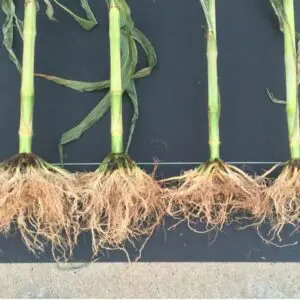
Strategies for reducing crop stress. . . because you can’t control the weather.
Strategies for reducing crop stress. . . because you can’t control the weather.
In farming, there is no more powerful and uncontrollable nemesis than the weather. Every aspect of a successful crop is influenced by the weather—from planting date to crop emergence and from weed pressure to disease occurrence—weather variability drives it all.
These weather extremes can’t be controlled, but there are ways to help crops withstand stress. Greg Binford, national director of Advanced Agronomic Training at Wilbur-Ellis offers these tips.
1. A resilient, healthy crop begins with healthy soil.
Optimum crop health and productivity begins in the soil where roots take up vital soil nutrients and moisture. Healthy soil is fundamental for establishing a robust, healthy root system.
“Better soil health usually translates into more resilient soil with better water-holding capacity. This helps crops to withstand the stress of prolonged periods of time without rainfall,” said Binford. “While it is hard to define soil health, an important and common characteristic of healthy soil is organic matter content.
“By increasing soil organic matter, the soil tends to have better water-holding capacity, better nutrient-holding capacity, better capability to supply nutrients, more microbial activity and better soil aggregation, so you get better rooting of the crop,” he explains.
2. Minimize tillage when possible and consider incorporating cover crops.
Minimizing or eliminating tillage and incorporating cover crops can help create more resilient soils.
When soil is tilled, oxygen is introduced into the soil, stimulating microbial activity. The microbes consume organic matter and carbon is released as carbon dioxide (CO2).
“The more tillage you do, the more organic matter is burned off,” Binford added. “Every time we till the soil, we also break up soil aggregates and break down soil structure. As you decrease tillage, you increase the ability to maintainorganic matter in the soil,” Binford pointed out.
The use of cover crops increases the time plant roots are growing within and infiltrating the soil, supporting healthy microbial activity, and helping create better soil aggregation. While farmers often give up on no-till or reduced tillage and using cover crops to enhance soil health and crop production, those who stick it out often see the benefit during times of extreme environmental stress such as drought and heat or excessive rainfall.
“Improving soil health doesn’t happen overnight, it’s a journey,” said Binford.
Robust plant roots also have an important symbiotic relationship with the beneficial microorganisms present in the soil. Root secretions help soil microorganisms more effectively protect the plant from disease, and the healthy soil microorganisms create space for new roots to develop by consuming dead root matter.
3. Enhance the soil biome with the latest generation of soil inoculants.
For more than 130 years, farmers around the world have incorporated inoculants into their crop production systems to enhance crop performance. The first were nitrogen-fixing “rhizobia” bacteria that colonize and establish nodules in the roots of host plants such as soybean and alfalfa. By fixing nitrogen (N) from the air, the rhizobia often supply the plants’ entire demands for N.
Similar plant-growth-promoting bacteria (PGPB) or plant-growth-promoting rhizobacteria (PGPR), may help plants in one or more ways including,
- Increasing root mass,
- the accumulation and transport of iron,
- solubilizing phosphorus to enhance plant uptake and
- stimulating the plants’ natural systemic resistance to abiotic stresses (wind, heat, cold, hail) and biotic stresses (insect or disease pressure; competition from weeds).

Commercially available products like the NUTRIO® line of beneficial microbials from Wilbur-Ellis are today’s generation of soil inoculants. The NUTRIO-brand products have been carefully selected and cultured from pure strains of microbes, then tested and proven to improve soil biodiversity and enhance nutrient mineralization in the soil. These products may be blended with conventional or organic fertilizers and soil amendments or impregnated onto dry fertilizers. When used as part of a comprehensive crop nutrient plan, they are proven to optimize root system development, plant growth, development, yield and quality.
“We’ve definitely seen increased yields and improved crop quality,” said Binford. “Our average yield increase in corn, through 66 comparisons, is nearly eight bushels per acre.”
Binford also recalled one of the first customer experiences from 2016 when NUTRIO UNLOCK® was introduced.
“A customer applied NUTRIO UNLOCK at planting, in-furrow on one-half of the field,” Binford said. “In August, when the corn was tasseled and grain began to fill, the area experienced dry conditions. From the road, you could see a distinct difference in the appearance of the crop.
“Where the corn didn’t have NUTRIO UNLOCK applied at planting, the leaves were rolled tighter and the plants were showing more drought stress,” Binford continued. “When our local agronomist dug plants from both areas of the field, there was a noticeable difference in the root systems. The plants in the treated area had bigger, more robust, expansive roots. That allowed them to reach farther and uptake more soil moisture. These plants were better prepared to endure the dry weather.”

4. Use foliar products prior to crop-stress events.
As early as the first century, seaweed was incorporated into soil as a crop enhancement. The first commercial seaweed extract was manufactured for agricultural use in the 1950s.
In addition to its benefits within the soil to increase germination, enhance seedling vigor and stimulate growth, compounds extracted from seaweed are being applied today to help plants deal with stress. From blueberries to apples, almonds and turf, seaweed extracts have been used as foliar treatments for years. The practice is being used in row crops as well.
“The use of seaweed extracts in row crops is a lot newer,” said Binford. “We offer FOLI-GRO TIDALWAVE®, a unique, concentrated seaweed extract with 0.35% EDTA zinc. It is very compatible and mixes well with most foliar-applied nutrients and pesticides, and it is designed to boost foliar nutrient availability and uptake.
“In row crops, we’ve also seen it used successfully in-season to help crops deal with challenges like herbicide stress, hail damage or dry weather,” he added. When applied before a stress event, compounds within the product kickstart the plants’ own system to produce stress compounds.
Since FOLI-GRO TIDAL WAVE can be tank mixed with fungicides, herbicides, insecticides and even liquid nitrogen prior to a period of extreme heat, combining the product with a fungicide application would be an ideal time to apply the product, according to Binford.
For more information about these products and other crop-management practices to help your crops withstand environmental and production stresses, contact your local Wilbur-Ellis agronomist.

